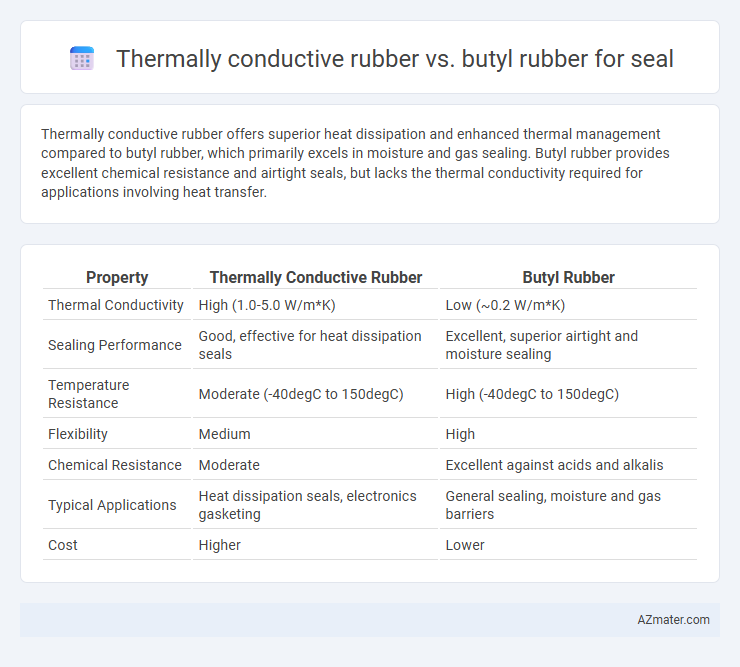Thermally conductive rubber offers superior heat dissipation and enhanced thermal management compared to butyl rubber, which primarily excels in moisture and gas sealing. Butyl rubber provides excellent chemical resistance and airtight seals, but lacks the thermal conductivity required for applications involving heat transfer.
Table of Comparison
| Property | Thermally Conductive Rubber | Butyl Rubber |
|---|---|---|
| Thermal Conductivity | High (1.0-5.0 W/m*K) | Low (~0.2 W/m*K) |
| Sealing Performance | Good, effective for heat dissipation seals | Excellent, superior airtight and moisture sealing |
| Temperature Resistance | Moderate (-40degC to 150degC) | High (-40degC to 150degC) |
| Flexibility | Medium | High |
| Chemical Resistance | Moderate | Excellent against acids and alkalis |
| Typical Applications | Heat dissipation seals, electronics gasketing | General sealing, moisture and gas barriers |
| Cost | Higher | Lower |
Introduction: Overview of Rubber Seal Materials
Thermally conductive rubber enhances heat dissipation in seals, making it ideal for electronic and automotive applications requiring efficient thermal management. Butyl rubber offers excellent airtightness, chemical resistance, and durability, commonly used in sealing applications exposed to harsh environments and gases. Comparing these materials highlights thermally conductive rubber's superior thermal performance, while butyl rubber remains favored for its impermeability and long-term stability in sealing solutions.
Key Properties of Thermally Conductive Rubber
Thermally conductive rubber offers superior heat dissipation due to its enhanced thermal conductivity, typically ranging from 1 to 5 W/m*K, compared to standard butyl rubber's low value of around 0.2 W/m*K. This type of rubber maintains good electrical insulation, excellent flexibility, and strong environmental resistance, making it ideal for sealing applications in electronics and automotive industries where heat management is critical. Its ability to withstand higher temperatures, often up to 200degC, surpasses butyl rubber's thermal limits, ensuring reliable seals under thermal stress.
Essential Characteristics of Butyl Rubber
Butyl rubber is prized for its exceptional impermeability to gases and excellent chemical resistance, making it ideal for sealing applications requiring long-term durability and airtightness. It demonstrates superior flexibility and resilience at low temperatures, maintaining a stable seal under thermal cycling and harsh environmental conditions. While thermally conductive rubber offers enhanced heat dissipation, butyl rubber excels in providing reliable sealing performance where moisture and gas barriers are critical.
Thermal Conductivity: A Critical Comparison
Thermally conductive rubber typically exhibits thermal conductivity values ranging from 1 to 10 W/m*K, significantly outperforming butyl rubber, which usually has values below 0.2 W/m*K. This superior thermal conductivity allows thermally conductive rubber seals to effectively dissipate heat in electronic assemblies and automotive applications. In contrast, butyl rubber seals, despite excellent chemical resistance and weatherability, are less suitable for applications requiring efficient thermal management due to their poor heat transfer capabilities.
Chemical Resistance: Performance in Harsh Environments
Thermally conductive rubber exhibits superior chemical resistance in harsh environments, maintaining stability against oils, fuels, and solvents while facilitating efficient heat dissipation. Butyl rubber offers excellent resistance to polar substances such as acids and alkalis but has limited compatibility with hydrocarbons and elevated temperatures. For applications demanding both chemical resistance and thermal management, thermally conductive rubber provides a balanced solution optimized for durability and seal integrity.
Mechanical Strength and Durability
Thermally conductive rubber exhibits superior mechanical strength with enhanced resistance to wear and deformation, making it ideal for seals requiring both flexibility and heat dissipation. Butyl rubber offers excellent durability due to its low permeability to gases and strong resistance to aging, ozone, and weathering, which ensures long-lasting seal integrity in harsh environments. While thermally conductive rubber combines mechanical robustness with thermal management, butyl rubber excels in chemical resistance and environmental durability, making the choice dependent on specific application demands.
Flexibility and Compression Set
Thermally conductive rubber offers enhanced heat dissipation while maintaining excellent flexibility, making it ideal for seals in high-temperature environments. Butyl rubber provides superior compression set resistance, ensuring long-term sealing performance and resilience under continuous pressure. Choosing between the two depends on balancing thermal management needs with durability and elastic recovery requirements in sealing applications.
Applications: Where Each Rubber Excels
Thermally conductive rubber excels in applications requiring efficient heat dissipation, such as electronic device seals, LED packaging, and automotive components exposed to high temperatures. Butyl rubber is preferred in sealing applications demanding superior impermeability to gases and moisture, like HVAC systems, tire inner liners, and pharmaceutical packaging. Each rubber's unique properties align with specific industry demands, making thermally conductive rubber ideal for thermal management and butyl rubber optimal for moisture and gas barrier seals.
Cost Efficiency and Lifespan Analysis
Thermally conductive rubber offers enhanced heat dissipation, making it ideal for electronic seals where thermal management is critical, but it generally comes at a higher initial cost compared to butyl rubber. Butyl rubber provides superior chemical resistance and excellent durability, resulting in a longer lifespan and lower maintenance costs for seals used in harsh environments. When evaluating cost efficiency, butyl rubber often delivers better value in long-term applications due to its resilience, whereas thermally conductive rubber justifies its premium price through performance in temperature-sensitive sealing tasks.
Conclusion: Choosing the Right Rubber for Sealing Applications
Thermally conductive rubber provides superior heat dissipation, making it ideal for electronic sealing applications where temperature management is critical, while butyl rubber offers exceptional chemical resistance and airtight sealing in automotive and industrial environments. Selecting the right rubber depends on the specific sealing requirements, such as thermal conductivity needs, exposure to chemicals, flexibility, and environmental durability. For high-temperature and electronic uses, thermally conductive rubber ensures performance efficiency, whereas butyl rubber excels in sealing against gases and moisture in harsh conditions.

Infographic: Thermally conductive rubber vs Butyl rubber for Seal
 azmater.com
azmater.com